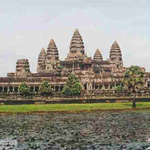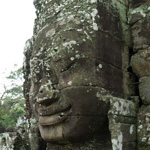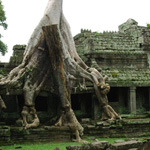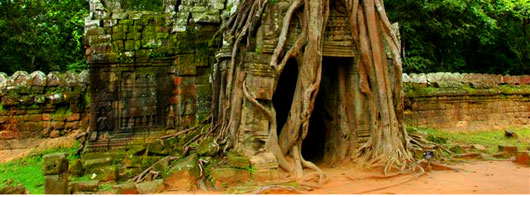Popular Temples
Angkor Wat
"Angkor Wat, in its beauty and state of preservation is unrivaled. Its mightiness and magnificence bespeak a pomp and a luxury surpassing that of a Pharaoh or a Shah Jahan, an impressiveness greater than that of the Pyramids, an artistic distinctiveness as fine as that of the Taj Mahal."D.H. Dickinson, Wondrous Angkor, 1937

Angkor Wat was built in the 12th century and its construction took approximately 30 years.
Symbolically, it represents the universe - from the replication of the peaks of Mt. Meru to the moat depicting the oceans. The complexity of this structure is revealed as you explore its varied levels, galleries, chambers and courtyards. The Gallery of Bas-reliefs that surrounds the first level of the temple contains almost 13,000 square feel of sandstone carvings whose craftsmanship is unrivaled in the world. As part of his tour, Saron will explain the stories behind these detailed images and point out the intricacies of the temple. It is impossible to describe in words the grandeur and majesty of the largest monument of the Angkor group. Your first glimpse will take your breath away.
Bayon
"We stand before it stunned. It is like nothing else in the land."H. Churchill Candee, Angkor: The Magnificent, The Wonder City of Ancient Cambodia

The Bayon temple stands at the exact center of the city of Angkor Thom. It was built some 100 years later than Angkor Wat, but vies with its larger counterpart as the favorite of visitors. There are over 200 smiling faces carved into its 54 stone towers, as well as extensive bas-relief images on its walls - it is simply fascinating.
Ta Prohm
"Ta Prohm's state of ruin is a state of beauty which is investigated with delight and left with regret."H. Churchill Candee, Angkor: The Magnificent, The Wonder City of Ancient Cambodia.

Ta Prohm has not been restored by archaeologists except for the clearing of paths and some structural reinforcements for safety. Ta Prohm continues to be swallowed up by the jungle, making it easy to imagine the awe of the explorers who first discovered it as you roam through its narrow corridors, enclosed courtyards, and crumbling towers. The roots of huge trees snake their way through the remains of the temple like the fingers of mother nature searching to reclaim her forest. The cool shade of the towering trees adds to the mysterious aura of the temple. It should not to be missed.
Admission
An admission pass is required to visit the temples during opening hours from 5:30AM - 5:30PM and is sold in one-day (US$20), three-day (US$40) or seven-day (US$60) blocks. Please note that these prices are scheduled to change in February 2017. The three day pass is valid for one week, i.e. 3 days to be used within the week, not necessarily consecutively. The seven day pass is valid for one month, i.e. 7 days to be used within the month, not necessarily consecutively. There are some "sunset" temples that are open until 6:00-6:20PM (depending on sunset time), such as Phnom Bakheng, Pre Rup and Phnom Krom. Always carry your admission ticket as it will be checked upon each entry and occasionally at major temples within the complex. Each tourist will have a photo taken at the entry check point to be printed on the admission ticket.
For futher information, see: http://www.canbypublications.com/siemreap/srstarted.htm
Temple Transportation
The temples are too far apart to make foot travel practical so most people either use a motorcycle taxi, a car taxi or rent a motorcycle. Except during big events and holidays, transportation is plentiful and easy to find. Saron Soeun can arrange transportation for you in advance and pick you up at the airport.
Siem Reap
There are many things to do in Siem Reap if you want a break from the temples. Some examples of alternative activities are:
- Culture Show - traditional Khmer costumes and performances
- Angkor Massage - help raise money for blind people by getting a soothing massage
- Shadow Puppetry - watch a show or buy your own puppet
- Les Chantiers Ecoles (Artisan Angkor School) - visit a self-sustaining school that teaches young people the art of stone and wood carving, lacquer-ware making, and silk weaving. The school has a shop where you can purchase high-quality crafts
- Central Market and old market - visit the lively market where the locals sell their wares
Tonle Sap
"Tonle Sap" means "the fresh water lake" or "the great lake" and it is the largest fresh water lake in South East Asia. During the rainy season, the Tonle Sap River (which normally drains into the Mekong River) reverses its flow, filling the lake to ten times its original size. The lake is one of the world's richest sources of biodiversity - fresh water fish, reptiles, and mammals. It also contains the Prek Toal Bird Sanctuary & Biosphere, home to many rare breeds. A trip to the Tonle Sap from Siem Reap will take you through picturesque villages where the inhabitants must live in floating homes because of the constantly changing shoreline. You will have the opportunity to visit any of these areas:
- Chong Khneas floating commune and flooded forest
- Kompong Phluk floating commune and great view of flooded forest
- Kompong Khleang floating & stilt commune and flooded forest
- Prek Toal village and bird sanctuary
Other Attractions
Some other things to see and do around Siem Reap Include:
- Silk Farm - see every step in the process of silk weaving, from silk worm breeding and harvesting to the finished product.
- West Reservoir - one of the largest man-made reservoirs in the world
- Crocodile Farm - 1 km from town, watch the crocodile feedings
- Kulen Mountain National Park and Waterfall
- Visit the village of Pradok and interact with the friendly locals
- The river of thousand lingas, reclining Buddha and Waterfall.
- Visit the rural villages at Preahdak commune and interact with the friendly locals.
- Visit the very far temples Beng Mealea, ancient quarry, Koh Ker and Preah Vihear temples
- ©2017 Saron Tours

